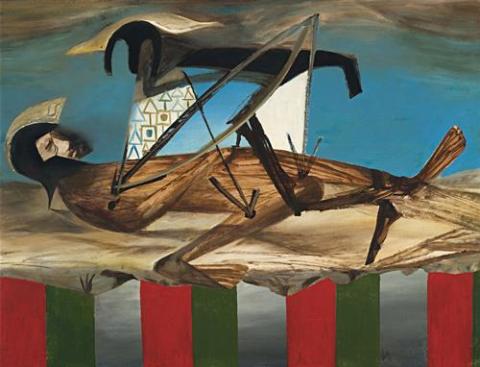GREEK WARRIOR, c.1955-56
Sidney Nolan
oil and enamel on composition board
89.5 x 118.0 cm
initialed lower right: N
The Estate of Pro Hart, Broken Hill, New South Wales
Sidney Nolan visited Greece in November of 1955, spending winter on the island of Hydra with his friend the writer George Johnstone and his wife Charmian Clift. Later he visited Gallipoli, birthplace of one of Australia's greatest legends. For the time, Nolan's interest in Kelly and Burke and Wills was spent. In seeking new inspiration he painted the Greek landscape and turned to reading Homer's Illiad and Robert Grave's Greek Myths, copies of which were lent to him by Johnstone. He was captivated by the dramatic richness of Homer's tale, of Helen whose unrivalled beauty launched the Trojan wars, and of their heroes. Nolan was enthralled, Johnstone writing that he 'wanted to paint Troy - in its pitiless heroics, in the true brutality of its images, within the impassive void of cosmic indifference; to alter those petrified costumed conceptions of Achaeans and Trojans so cloyingly fixed by the painters of the Renaissance; to give the story back the savage, sweaty, cruel, dusty, unadorned human grandeur that Homer had sung.'1 Greek Warrior, one of many derived from Greek mythology, is a perfect translation of that desire. Already a master of the visual epic, Nolan produced a metaphoric recollection of the great heroes of ancient Greece, of Achilles and Ulysses, and their worthy opponent, Hector of Troy. The helmeted warrior in battle, falling with angular shield and spear could be one and all three, the figure prefiguring the pyre and funereal games of farewell as the shades of heroes passed into the underworld of Pluto and Persephone.
Nolan's enthusiasm was so great that Johnstone recalls him painting 'in a ferment of excitement for five months, experimental sketches in oils or inks' hundreds and hundreds of studies concerned with nude figures interlocked and grappling, centaur-like horsemen, desiccated skulls and bones in formalized masks and helmets, the harsh edges of dryrock and brittle, snagged vegetation against burning bright skies.'2 The excitement grew even stronger when this led to another obsession, of the ANZACS at Gallipoli. It also came through Johnstone, who introduced him to Alan Moorehead's writing on the subject. The young nation's heroic battles at Gallipoli and that of the ancients' epics on the plains of Troy coalesced in Nolan's mind, the human struggle of one finding a recent parallel in the other. 'I think I might tackle Gallipoli first' as a way of feeling into the bigger thing of Troy.'3 The Greek heroes soon gave way to those of Anzac in one of Nolan's greatest series of paintings. But the Greek myths were not entirely forgotten as the many grand paintings of Leda and the Swan bare testament.
1. Johnstone, G., 'Gallipoli Paintings', Nolan Issue, Art and Australia, vol. 5, no. 2, September 1967, p. 466
2. ibid.
3. Nolan quoted in Johnstone, op.cit., p. 247
DAVID THOMAS
